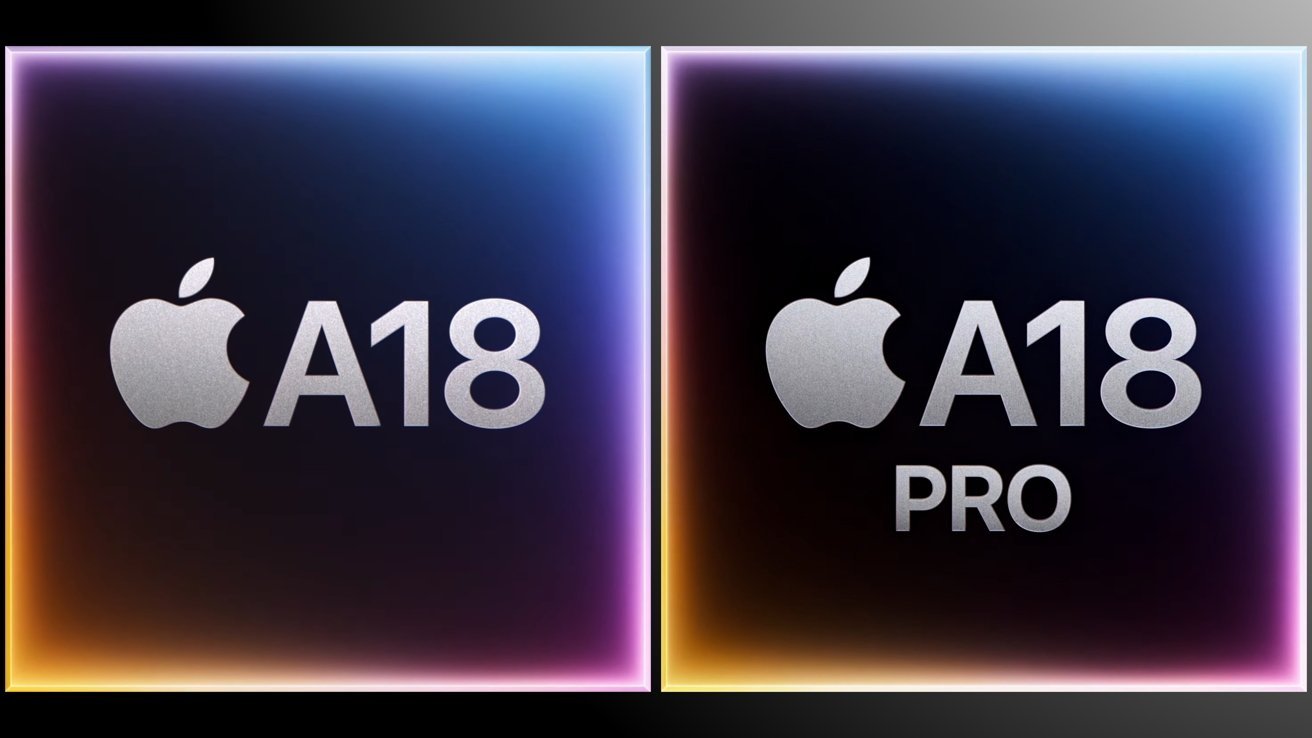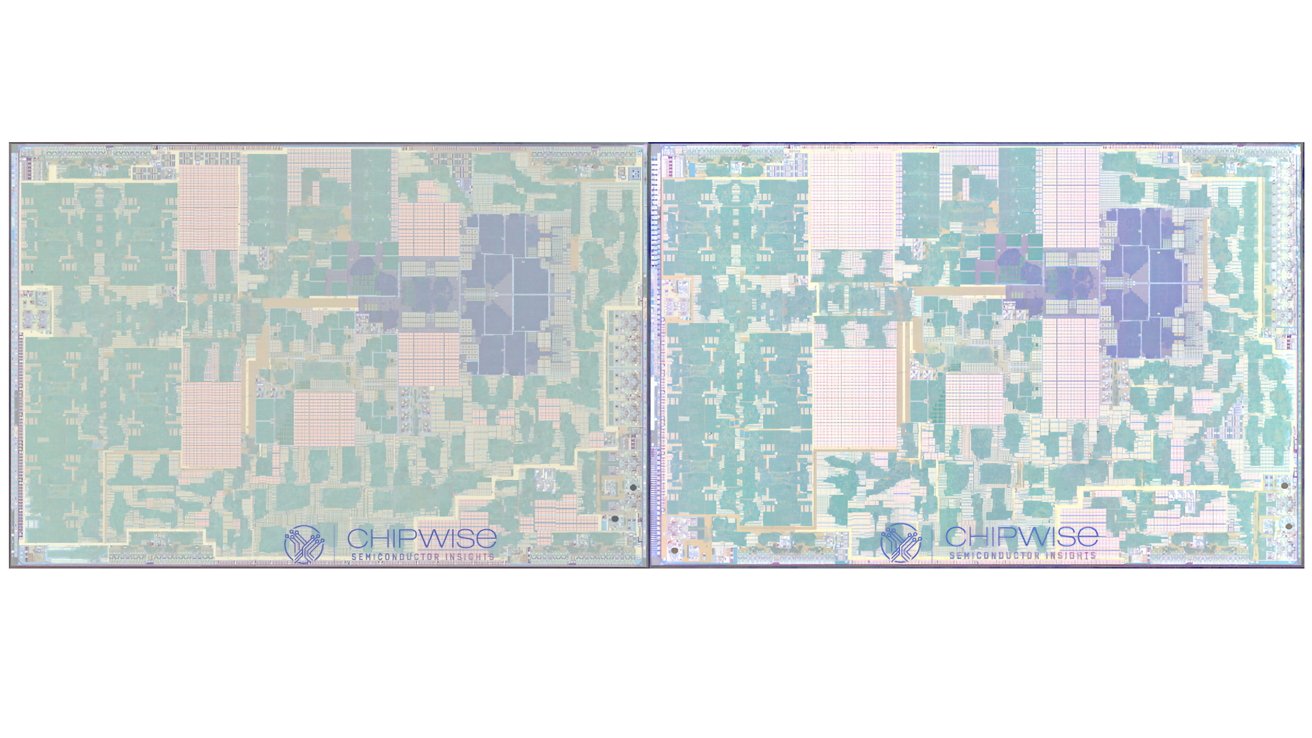iPhone 16 A18 processor isn't a 'binned' A18 Pro
New microphotography of the A18 and A18 Pro chips reveal the inner workings of the iPhone 16 line's chips, as well as confirming Apple isn't using chip binning right now.

Apple's branding for the A18 and A18 Pro chips.
Apple's chips in its products are impressive, giving other processor makers a run for their money over the years. As the designs improved, so did the performance and capabilities of its hardware, as is evident in the iPhone 16.
Following after teardowns, the next logical step is to closely examine the chips, and Chipwise has done just that. It has published photographs of the dies used in the A18 and A18 Pro.
The packaging of the chip has been consistent over the years, with TSMC using an Integrated Fan-Out Package-on-Package (InFO-PoP) method for a while. The technique stacks a DRAM package on top of the SoC die, with high-density redistribution layers and a Through InFO Via assisting to create a compact overall chip size.
In other words, Apple stacks the memory on top of the CPU and GPU, instead of having them in a separate die.

Die shots of the A18 (left) and the A18 Pro (right0 [via Chipwise]
The shots of the A18 SoC shows off its 3-nanometer manufacturing process, and a fairly straightforward layout. Cores and other elements are clustered together, almost like fields in an overhead shot of a countryside landscape.
Checking over the die shot for the A18 Pro, it does at first glance appear to be very similar to the A18's version. You can see where clusters are placed in similar locations, and it would be quite easy to mistake one for the other from these images alone.
However, a more careful examination shows that Apple has included a lot more transistors on the A18 Pro. Many of the lighter sections take up a lot more space on the die compared to what's on the A18.
The images at least prove that Apple isn't simply performing chip binning. This is a process where a Pro chip would be made, but faulty versions with a failed core could be repackaged as non-Pro A18 chips instead.
It was believed that the A18 was going to be a binned version of the A18 Pro, since it relies on one fewer GPU core. With similar features like Apple Intelligence support and hardware-based ray tracing, it was easy to believe chip binning was at play.
With the differences evident in the shots, it seems that Apple is legitimately designing and producing two different chips, instead of relying on chip binning.
Read on AppleInsider

Comments
The CPU complex looks odd? They are bilaterally symmetric, but are not typically rectangular. Have to wait for a floorplan.
There is the possibility that the A18 Pro represents the future of A-series SoC design and that A19 SoCs will resemble the A18 Pro instead of the A18. Only time will tell on that front. One thing we do know is that AI assisted chip layout is happening more frequently and will likely continue to become more popular as time goes by. Is the A18 Pro an AI-assisted chip layout design? Only Apple Engineering knows right now...
It's worth pointing out that the A17 only appeared in a few products so we might be in the midst of some sort of tectonic shift happening right now in terms of Apple Silicon design.
What I find interesting is that the A18 Pro has more transistors than the regular A18? What are those extra transistors for? They aren't an extra CPU or GPU core. We already know that Apple has increased the power of the Neural Engine subsystem. Have they developed another type of differentiation that is waiting to be unlocked by a future version of iOS? Lots of unanswered questions but it is still very soon after the iPhone 16 launch and iOS 18 is far from feature completeness.
The A18 Pro is larger, has more transistors than the A18 because of larger SLC and L2 caches. Looks like to be about 50% more just eyeballing it. Then the aforementioned GPU core, ProRes encode block, and maybe others.
iPad, iPad mini, Apple TV, "HomePod with display" can use the A18 or A18 Pro. Like they can offer 2 models of the Apple TV, one with A18 for the base, A18 Pro for the upgraded option. Same can be done for iPad mini, and iPads.
Even some Macs can be made with A18 or A18 Pro SoCs, but Apple isn't going to do that.
Hell, I see no reason why Apple TV needs any version of the A18 right now.
The fact that A18 and A18 Pro chips are both TSMC N3E chips don't explain why Apple differentiated between the two. There is something else. If there is no difference, Apple would not have burned the extra time/effort/dollars to create separate chips.
Apple is producing an A18 Pro because they think the features it enables is worth it. It enables features on A18 Pro models that the A18 can't or doesn't do so well. The ProRes encode block is obvious. The increased caches all goes towards more performant photos, videos features. It gives the iPhone Pro models an edge, and another reason for customers to buy.
Apple has segmented the Apple TV 4K models more than you would think. You get +64 GB storage, Ethernet, and Thread radio for +20$. Say, for fall of 2025, an A18 Pro version could be had for $200? They can do this for the iPad and iPad mini. Make the upsell more attractive. If they can add Intelligence features to Apple TV, it would give them features that most other streaming boxes can't.